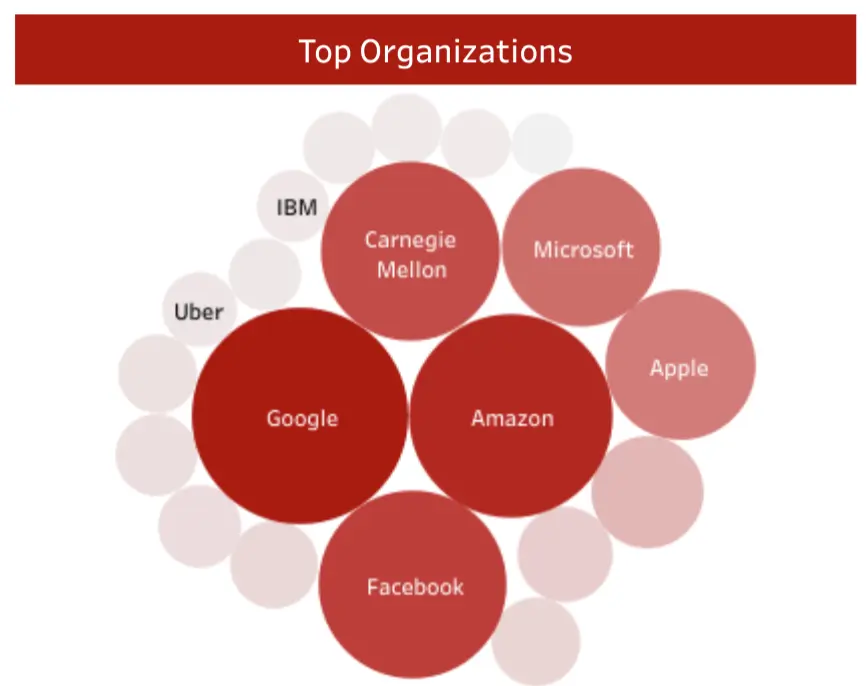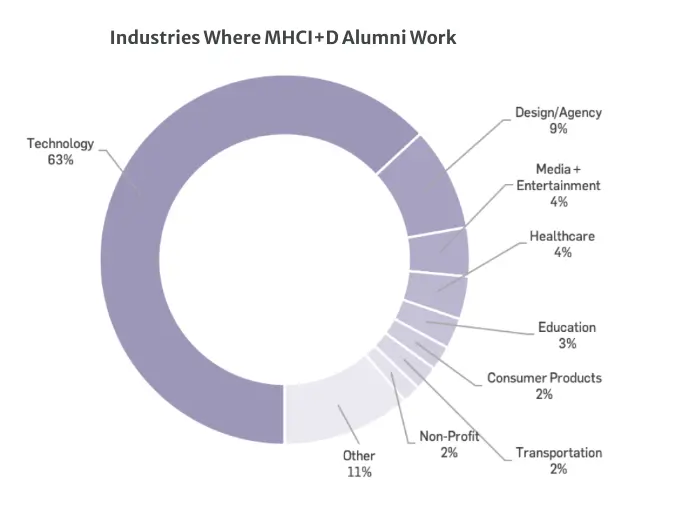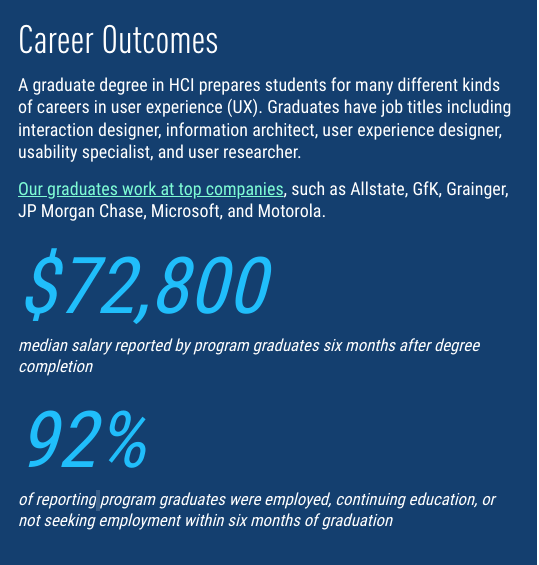Time, money, and a whole lot of hard work. Enrolling in a UX design program is a huge commitment—so you want to make sure you make the most informed choice.
In this article, we’ll explore our 10 best masters in UX design programs.
We’ll then answer the question of whether you should do a masters in UX design or whether an online UX certification or other bootcamp may be a better option for you.
To skip ahead to a section, simply use this clickable menu:
Top 10 masters in UX design programs
Masters in UX design often have very different official course titles, despite covering the same material. For the purpose of assessing a wide range of masters programs in this article, we have included those with titles other than UX design.
Let’s explore some of the best masters programs out there!
1. Carnegie Mellon University:
Master of Human-Computer Interaction
Length: 1 year
Total tuition: $77,784
Location: Pittsburgh, PA
Class size: 60 students/year
Attendance: Full-time preferred; part-time possible
Format: Campus
Founded: 1997
Application fee: $100
ADMISSION REQUIREMENTS
GPA: No min
SOP: Required
Resume: Required
Recommendation: 3 letters
TOEFL: 100 (25 per subsection)
IELTS: Not required
GRE: Required
Portfolio: Optional
The Master of Human-Computer Interaction (MHCI) at Carnegie Mellon University is one of the best UX design masters.
Self-described as “the first program in the world dedicated to preparing professionals for careers related to human-computer interaction, user experience design, and user-centered research,” the program draws students from a huge range of backgrounds.
Students with varying degrees of industry experience—and backgrounds in design, social science, business and computer science, and more—attend the (generally full-time) one-year program on campus in Pittsburgh, PA.
One factor behind its strong reputation is that Carnegie Mellon University is known for its tough admission criteria. Graduates are respected not only in the design space but also in the broader world of tech.
Their comprehensive Post-Graduation Outcomes Dashboard highlighted the number of their graduates who find employment with the likes of Google, Amazon, Facebook, Microsoft, and Apple:

Source: Carnegie Mellon University
2. Stanford University: M.S. in Design Impact
Length: 2 years
Total tuition: $75,240
Location: Stanford, CA
Class size: 13 students/year
Attendance: Full-time
Format: Campus
Founded: 2018
Application fee: $125
ADMISSION REQUIREMENTS
GPA: No minimum
SOP: Required
Resume: Required
Recommendation: 3 letters
TOEFL: 100
IELTS: Not required
GRE: Not required
Portfolio: Required
Regularly ranked in the top two or three US colleges, and in the top three or four worldwide, Stanford University is a globally acclaimed institution.
Its M.S. in Design Impact (DI), a full-time, two-year program established in 2018, shares that reputation.
Founded on the idea that design is broader than products, experiences, and systems, the program explores “the technologies and data that power the above” as well as “the implications and consequences of all of our work in the world in the short and long term.”
With the objective of grounding students in the full problem space of this interconnected landscape, the M.S. in Design Impact has three focus areas:
Design Core: Including Project-Based Design Work, Human Factors, Design Ethics, Leadership, and Visualization
Methods: A choice of three focus areas that enable students to effectively implement their design abilities with methods such as analysis, describing phenomena, and design problem application.
Domain: A domain focus area from appropriate courses to gain added knowledge in a field of interest to them.
3. Georgia Tech:
Master of Human Computer Interaction
Length: 2 years
Total tuition: $70,816/2 years (out-of-state); $32,128/2 years (in-state)
Location: Atlanta, GA
Class size: 52 students/year
Attendance: Full-time
Format: Campus
Founded: 1998
Application fee: $85
ADMISSION REQUIREMENTS
GPA: 3.0
SOP: Required
Resume: Required
Recommendation: Asked letters
TOEFL: 100
IELTS: Not required
GRE: Required
Portfolio: Optional
Established in 1998, Georgia Tech’s Master of Human Computer Interaction (MS-HCI) is something of a veteran among the programs we look at. It has both a very strong US reputation and a growing global one.
Like many of the masters in UX design and HCI, Georgia tech’s program is an interdisciplinary offering. Four schools offer the program collaboratively:
- Industrial Design
- Interactive Computing
- Literature, Media, and Communication (LMC)
- Psychology
Its aim is to equip students with the practical skills and theoretical understandings they need to develop into “leaders in the design, implementation, and evaluation of the next generation of human-computer interfaces”.
4. New York University: Integrated Design & Media, M.S.
Length: 2 years
Total tuition: $115,680
Location: New York, NY
Class size: 110 students/year
Attendance: Full-time
Format: Campus or online
Founded: 1979
Application fee: $65
ADMISSION REQUIREMENTS
GPA: No minimum
SOP: Required
Resume: Required
Recommendation: 2 letters
TOEFL: Not required
IELTS: Not required
GRE: Required
Portfolio: Required
New York University’s MS in Integrated Digital Media has built its reputation as one of the best UX masters programs because of its emphasis on art and aesthetics. It combines art and technology in a unique, challenging, and fluid way.
Only the second program on our list to offer students the chance to learn online or with a blended mix of campus and online, the Integrated Design & Media, M.S. is set up to cater to all career levels.
And—whatever career stage you’re at— you’ll get to experience new ways of understanding culture, technology, and society and how these inform technological design.
If “The Big Apple” holds the same mystique for you as it does for most of us, you can tap into an unparalleled cultural and technological experience right at its core.
5. University of Washington:
Master of Human-Computer Interaction and Design
Length: 1 year
Attendance: Full-time
Total tuition: $$55,430 (2023-24)
Location: Seattle, WA
Class size: 30 students/year
Format: Campus
Founded: 2013
Application fee: $85
ADMISSION REQUIREMENTS
GPA: 3.2
SOP: Required
Resume: Required
Recommendation: 3 letters
TOEFL: 106 (26 speaking)
IELTS: Not required
GRE: Not required
Portfolio: Optional
Taught on campus in Seattle, the University of Washington’s Master of Human-Computer Interaction and Design (MHCID) is undoubtedly one of the finest masters in UX design out there.
It’s a multidisciplinary program, with course content provided collaboratively by four departments:
- Computer Science & Engineering
- Human-Centered Design & Engineering
- The Information School
- Division of Design in the School of Art + Art History + Design
The program’s unique, cross-disciplinary approach is designed to cultivate “a new generation of designers, engineers, and researchers” with an education that enables them to “successfully combine the creative aspects of design and the study of human behavior with the analytical techniques of engineering”.
And—judging by their strong graduate outcomes—they’re doing something right.
95% of the program graduates are employed within six months (70% within three months and the majority join large enterprises (5,000+ employees) in tech. This infographic from the course website shows where their graduates land:

Source: University of Washington
6. UC Berkeley: Master of Design
Length: 1.5 years
Total tuition: $73,130
Location: Berkeley, CA
Class size: 23 students/year
Attendance: Full-time
Format: Campus or online
Founded: 2020
Application fee: $140
ADMISSION REQUIREMENTS
GPA: 3
SOP: Required
Resume: Required
Recommendation: 3 letters
TOEFL: 90
IELTS: 7
GRE: Not required
Portfolio: Required
UC Berkeley’s reputation is global, and it won’t surprise many to see its Master of Design (MDes) feature in our list.
Based on three pillars—technical rigor, design theory, and social practice—the program is aimed at early to mid-career professionals who want to pursue work “at the intersection of design and technology”.
With this in mind, UC Berkeley students are offered the chance to work in fields such as artistic production, technological innovations, product design, and design interventions in cities.
Students are also pushed to develop intelligent new approaches and design toolkits to respond to the changing dynamics of technologies like artificial intelligence, augmented and virtual reality, sensing, and the internet of things.
At the same time, they’re encouraged to take a wider perspective and understand the underlying ethical concerns and questions about their possible, often unforeseen, impacts.
7. California College of the Arts:
MDes in Interaction Design
Length: 1 year
Total tuition: $63,900
Location: San Francisco, CA
Class size: 45-60 students/year
Attendance: Full-time
Format: Campus or online
Founded: 2016
Application fee: $70
ADMISSION REQUIREMENTS
GPA: No minimum
SOP: Required
Resume: Required
Recommendation: 2 letters
TOEFL (or IELTS): 100
IELTS (or TOEFL): 7.5
GRE: Not required
Portfolio: Required
Staying on the west coast—the heart of Silicon Valley to be precise—the MDes in Interaction Design at California College of the Arts is the next masters on our list.
Promising aspiring designers the chance to “build the most in-demand design toolkit in the world today” this is a program focused on cultivating systems thinking, design leadership development, and iteration and collaboration skills.
Priding itself on creating skills that can have “measurable social impact”, this MDes is centered on designing for the environment, public health, transportation, education, and other major industries.
8. Parsons School of Design:
M.F.A. in Design and Technology
Length: 2 years
Total tuition: $103,500
Location: New York, NY
Class size: 80 students/year
Attendance: Full-time
Format: Campus or online
Founded: 1997
Application fee: $50
ADMISSION REQUIREMENTS
GPA: No minimum
SOP: Required
Resume: Required
Recommendation: 2 letters
TOEFL (or IELTS): 92
IELTS (or TOEFL): 7
GRE: Not required
Portfolio: Required
Another New York-based option, Parsons School of Design offers an M.F.A. in Design and Technology (DT) which takes a broad and critical approach to tech. Students at Parsons will enter a dynamic, challenging, idea-driven environment that pushes them to think about the “ever-present impact that computational technologies have on our lives”.
With a wider scope than some other masters programs in the field, students at Parsons can focus on areas of practice including wearable technology, game design, new media art, digital fabrication, physical computing, interaction design, data visualization, and critical design.
9. DePaul University:
M.S. in Human-Computer Interaction
Length: 2.5 years
Total tuition: $44,980 (2022-23)
Location: Chicago, IL
Class size: 100 students/year
Attendance: Full-time, part-time
Format: Campus and online
Founded: Unknown
Application fee: $25
ADMISSION REQUIREMENTS
GPA: 2.5
SOP: Not required
Resume: Required
Recommendation: Optional letters
TOEFL (or IELTS): 80 (17 each subsection)
IELTS (or TOEFL): 6.5
GRE: Not required
Portfolio: Not required
Part of DePaul University’s Jarvis College of Computing and Digital Media, the Master of Science in Human-Computer Interaction (HCI) program teaches students how to “ideate, design, implement, and evaluate computer-based technologies so they are useful and usable for end users.”
An interdisciplinary degree, the program draws on concepts and methods from computer science, graphic design, and the social sciences to offer a well-rounded education.
Students are encouraged to pursue user-centered and participatory design approaches in creating dynamic websites, mobile apps, desktop applications, and more.
DePaul’s program has a good reputation with employers and graduates have found well-remunerated employment with a range of major corporations, as this graphic from the course website illustrates:

Source: DePaul
10. Rochester Institute of Technology:
M.S. in Human-Computer Interaction
Length: 2 years
Total tuition: $100,272
Location: Rochester, NY
Class size: 25 students/year
Attendance: Full-time, part-time
Format: Campus or online
Founded: 2004
Application fee: $65
ADMISSION REQUIREMENTS
GPA: 3
SOP: Required
Resume: Required
Recommendation: 2 letters
TOEFL (or IELTS): 88
IELTS (or TOEFL): 6.5
GRE: Required
Portfolio: Not required
Based in Rochester, NY, a small city (by US standards) on the shore of Lake Ontario, Rochester Institute of Technology (RIT) boasts an acclaimed M.S. in Human-Computer Interaction (HCI).
Students explore “the design methods, evaluation, and implementation of interactive computing systems for human use” to build the skills needed for a career in UX design or research. They focus on creating professionals who understand the shift away from the desktop user and know how evolving tech can be designed to be intuitive, effective, and even compelling.
Perhaps unsurprisingly—with program hiring partners including the likes of Cisco, HubSpot, HP, Bose Corporation, and many more—graduates from RIT tend to fare well in their careers. Graduates report job titles such as UI/UX Designer, Interaction Designer, Usability Specialist, Product Designer, and User Experience Researcher.
Now that we’ve looked at ten of the best masters in UX design out there, let’s quickly wrap up with some final thoughts.
Should you do a masters in UX design?
There is no easy answer to this, other than: “it depends”.
There are many factors that you’ll need to weigh up before deciding whether to do a UX design master.
Ultimately, it will hinge on your unique personal situation, so think about things like:
- How much time you can invest (and whether you can study full-time or part-time)
- How much money you can invest
- Whether you can relocate for campus study if required or would rather go online
- Whether you need an accredited program (if you’re an expat or soon-to-be expat for example)
- How much the prestige (or otherwise) of the institution matters to you
- Your learning style
- Your career goals
We realize this is a lot to think about. So—to help you get started with your decision—here are three win pros and cons of UX design masters, as opposed to UX design certifications.
Pros of masters in UX design
- Prestige: Some masters in UX Design (or HCI) carry more prestige than other types of certification. This will vary from employer to employer though, and UX teams at the best employers are often made up of designers with masters degrees, online certifications, and even self-taught skills.
- Career prospects: Related to the prestige factor, some employers will look more favorably on candidates with a UX design masters over a certification. Bear in mind that this generally applies less and less the further along in your career you get, as your experience and portfolio—and ability to explain them both—become key drivers of your career path.
- Formal and structured: Masters in UX design are typically more formal than other UX certifications and often require in-person attendance at lectures or seminars.
Cons of masters in UX design
- Long: Doing a masters in UX design will take you a minimum of one year of full-time study, often going to two years or even longer. Meanwhile, online UX certifications can be completed much more quickly (CareerFoundry: 5-10 months, UX Design Institute UX Design Diploma: 6 months or less, General Assembly UX Design Immersive: 12 weeks full-time)
- Expensive: Unless you can secure a scholarship or other subsidies, a masters in UX design can be incredibly expensive. The masters we look at in this article range from $44,980 to $115,680, and that’s for the tuition fees alone, without factoring in your living expenses and so on.
- Geographical limitations: Some masters require, or strongly prefer campus study. This can be limiting for those not able or willing to relocate to study. Online UX certifications, on the other hand, are available to you regardless of geography.
If you’d like to explore online certifications more, we recommend checking out Emily Steven’s The Best UX Design Certification Programs: A Complete Guide.
Alternatively, if you’d like to read more on the pros and cons of accredited courses (masters degrees) and non-accredited (most online certifications), our article on The 7 Best UX Design Schools will be right up your alley.
Wrap-up
Before you apply for any UX design course, be it a masters or an online certification, do your research and figure out if the course is suited to your unique personal situation, learning preferences, and career goals.
Whether or not you apply to do a masters will ultimately depend on whether you can make and justify the time, logistical, and financial commitments required.
And remember: in the medium to long term, when you’re three or four years into your career, where you studied will be far less important to prospective employers than your work experience and portfolio.
How persuasively and logically you can explain your design decisions, and how well you can collaborate and engage stakeholders or clients will count for a lot more than whether you studied at Stanford or completed an online certification.
If you’re interested in reading more about UX design, try the following articles:
